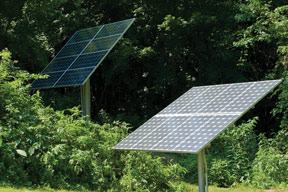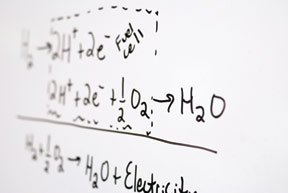Let’s say you want to improve safety on a remote section of highway through a mountain pass via a road condition monitoring system. A small automatic weather station beside the road plus several cameras in key locations could provide a good approximation of road conditions. This information could be posted on dynamic message signs along the approaches to the pass as well as on traffic monitoring Web sites. Maintenance and rescue personnel could be dispatched when needed based on real-time data instead of having to send inspectors to check conditions on the road. Sounds great, but what is the cost of implementing a system like this?
Thanks to modern electronics, the cost for a hardware installation in that remote mountain pass is shrinking every year. The bigger problem? Ten miles of transmission lines that must be strung across rugged terrain to power these helpful gadgets to make this road safer and more convenient for travelers. If only there was a way to power this system without ten miles of wire and all the poles to hold it up. …
Today, there are new alternatives; alternative energy sources, that is. For a fraction of the cost and time to run ten miles of power line and hook into the grid, an off-grid power supply can have your new road monitoring system up and fully functional. Today, you can get electricity from the sun and wind for free (well, almost free). New fuel cells and improved batteries can keep everything running when the sun sets and the wind is calm. What’s more, these new alternatives are following the path that electronics has been on for decades: performance is improving while costs are dropping. That’s more than the power company can offer!
Let’s take a look at a few alternative energy sources available to help you “cut the cord” from the grid.
Solar Power
The sun sends more energy to the earth each day than we consume in a year. By using photovoltaic (PV) materials such as silicon, light energy from the sun can be converted into electrical energy that can be stored in a battery or used by an electrical appliance. PV material releases electrons in the form of direct current (DC) electricity when exposed to light. This phenomenon is known as the photoelectric effect.
 Silicon wafers are made into PV cells which are connected in series and parallel to make up solar panels. Panels can be assembled to deliver whatever voltage and amperage is required for an application. Groups of panels can be connected together to deliver larger power outputs.
Silicon wafers are made into PV cells which are connected in series and parallel to make up solar panels. Panels can be assembled to deliver whatever voltage and amperage is required for an application. Groups of panels can be connected together to deliver larger power outputs.
A new type of solar power generation is thin film photovoltaics. Instead of slicing silicon to make individual wafers which must be soldered into rigid panels, PV material is deposited directly on the substrate, essentially making one large solar cell for a fraction of the cost. The latest developments are adapting technology from the printing industry to produce rolls of PV material that are thin and flexible enough to fit nearly any contoured surface.
Of course, there is one significant drawback to solar power generation: when the sun stops shining, the juice stops flowing. Power output for a solar panel will vary based on the intensity of the sunlight striking its surface. Reliable off-grid power systems therefore need to have a way to store energy (typically with batteries) to keep up with demand during dark hours. A robust control system to prevent overcharging batteries and to balance supply with load is also a must for industrial applications.
Wind Power
Man has been harnessing the wind for centuries. Wind turbines can now convert a stiff breeze into kilowatts. Large wind farms are being built all across the globe. While these wind farms are normally tied to the grid, smaller wind power systems can be used for off-grid applications like our road monitor in the mountain pass.
 A modern wind turbine usually has two or three blades mounted to spin on a horizontal shaft; this shaft is coupled to an electric generator. Large turbines are usually set up to produce alternating current (AC) since they are connecting to the grid; smaller turbines typically produce DC electricity. As with sunlight on solar cells, stronger winds mean more power. Large modern wind turbines have servomotors to control blade angles and keep the turbine pointed into the wind to maximize power output.
A modern wind turbine usually has two or three blades mounted to spin on a horizontal shaft; this shaft is coupled to an electric generator. Large turbines are usually set up to produce alternating current (AC) since they are connecting to the grid; smaller turbines typically produce DC electricity. As with sunlight on solar cells, stronger winds mean more power. Large modern wind turbines have servomotors to control blade angles and keep the turbine pointed into the wind to maximize power output.
Wind power has the problem of fluctuating power output similar to solar unless you happen to be located in a rare location which is always windy. This means wind power systems also need batteries and controls to maintain power output at desired levels while protecting components. Initial cost of a small wind turbine can be quite low.
Fuel Cells
A fuel cell is an electrochemical device that converts a fuel and oxidant into electrical power. Unlike batteries, which are also electrochemical, fuel cells consume the fuel and oxidant during the reaction to produce electricity. This means that a remote site will need to be visited periodically to replenish the fuel. Fuel cells can deliver significantly more power than traditional battery packs, making them a promising option to supplement solar or wind power systems off grid.
A fuel cell uses a chemical reaction to separate electrons and protons from the fuel and then force the electrons to travel through a circuit, thus creating electrical power. The typical construction uses a proton exchange membrane (PEM) to separate an anode and cathode. Fuel on the anode side reacts with a catalyst to split into protons and electrons. The protons pass through the PEM toward the cathode, but the electrons must flow out of the cell through the load to reach the cathode. At the cathode, the protons and electrons react with the oxidant to form waste products.
The purest form of fuel cell uses hydrogen fuel and oxygen to produce electricity and water. Other types use hydrocarbon fuels such as diesel or methanol and give off carbon dioxide and water as waste products. Although not as clean operating as hydrogen, these other fuels are often much easier to store and transport.
This is still a developing technology – look for significant advances in the years to come. Now that we have a better understanding of what’s available for off-grid applications, it’s time to start thinking outside of the box! Here are a few ideas to get you started:
Telecommunications
This is not really outside the box since there is already significant use of alternative power for remote telecom equipment. But, there is still room for more creative applications in the industry. Possibly small cellular phone towers could be installed around wilderness areas to allow hikers and campers to communicate with the outside world if the need arises.
Oil & Gas
For maximum efficiency, sensors and control equipment could be installed along pipelines where needed, instead of at sites which are convenient to power sources. Systems can be monitored more effectively by using more sensors distributed across a larger area. Offshore platforms can reduce operating costs by tapping into the nearly-free power of the sun and wind. Cathodic protection to prevent pipeline corrosion is another excellent application for alternative energy.
Traffic Management
As we saw in the example at the beginning of this article, by removing the often daunting requirement of connecting any powered monitoring or notification equipment to the electrical grid, these components can now be located where they are the most beneficial. Traffic counters and dynamic message signs can keep traffic informed of conditions ahead wherever needed, not just in the cities. Adding lighting to a dangerous section of road can be done more quickly and often at lower cost.
Security Systems
Many industrial and commercial operations cover a large area of land. Off-grid lights, sensors and cameras can simplify installation and enhance security in areas that may be neglected if only using line-powered equipment. Now a light, camera, and powered gate can be located in a remote section of a property to privide secure access where needed. Call boxes and motion detectors can be more widely used.
Agriculture
Irrigation water pumping and lighting using solar or wind power can reduce farmers’ fuel costs. Because there is usually plenty of land and large roofs available for installing an alternative power system, most farms could easily operate full-time off the grid. The best reason to stay connected could be a solar or wind power system on a farm will probably have surplus energy which can be sold back to the local power company.
Village Electrification
There are an estimated two billion people living without access to electrical power grids. So, this is an industry with huge growth potential. In developing nations, large scale power generation and grid expansion projects often progress slowly or not at all due to the tremendous costs in both cash and people. Incremental steps using small, simple off-grid solutions can give these communities access to many of the services that most of us would consider necessities.
Water pumping and sewage treatment facilities could make a significant improvement to the quality of life in a remote community. New LED lights that use very little power now make it possible to install low voltage lighting powered by alternative energy sources. Refrigeration, especially in warm climates, is essential for many medicines and foods.
There are a number of organizations developing appliances and systems that can be operated off-grid in small remote communities. Access to electricity and electric-powered conveniences for many of these communities is a big step towards prosperity.
Other Applications
Many applications can benefit from a widespread system of sensors: seismic monitoring, wildfire detection, and creek and river level monitors, to name a few. Temporary power supplies for use during disaster relief are another excellent application. Park management could upgrade facilities without the environmental impact of stringing power lines through a wilderness area, which reduces cost and time.
We’ve touched on the basics in this article, but hopefully I have given you a few alternatives to consider. Alternative energy supplies and the systems that use them will become more and more common in the coming years. No longer shall we be tied to the grid! The cord is cut and the sky’s the limit.
By Pat Philips
AutomationDirect,
Product Engineer
Originally Published: Dec. 1, 2009


